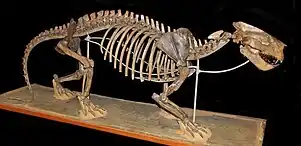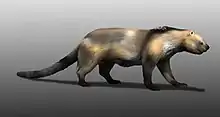Oxyaeninae
Oxyaeninae ("sharp hyenas") is an extinct subfamily of placental mammals from extinct family Oxyaenidae, that lived in Asia, North America and Europe from the late Paleocene to middle Eocene.[1][2]
| Oxyaeninae | |
|---|---|
 | |
| Patriofelis ferox skeleton | |
 | |
| Reconstruction of Sarkastodon mongoliensis | |
| Scientific classification | |
| Domain: | Eukaryota |
| Kingdom: | Animalia |
| Phylum: | Chordata |
| Class: | Mammalia |
| Clade: | Pan-Carnivora |
| Order: | †Oxyaenodonta |
| Family: | †Oxyaenidae |
| Subfamily: | †Oxyaeninae Trouessart, 1885 |
| Type genus | |
| †Oxyaena Cope, 1874 | |
| Genera | |
| |
| Synonyms | |
| |
Etymology
The name of the subfamily translates as "sharp hyaenas" (from Ancient Greek ὀξύς- (oxús-) 'sharp', name of hyena genus Hyaena and taxonomic suffix "-inae").[3]
Classification and phylogeny
Taxonomy
- Subfamily: †Oxyaeninae (Cope, 1877)
- Genus: †Argillotherium (Davies, 1884)
- †Argillotherium toliapicum (Davies, 1884)
- Genus: †Dipsalidictis(paraphyletic genus) (Matthew & Granger, 1915)
- †Dipsalidictis aequidens (Matthew & Granger, 1915)
- †Dipsalidictis krausei (Gunnell & Gingerich, 1991)
- †Dipsalidictis platypus (Matthew & Granger, 1915)
- †Dipsalidictis transiens (Matthew & Granger, 1915)
- Genus: †Malfelis (Stucky & Hardy, 2007)
- †Malfelis badwaterensis (Stucky & Hardy, 2007)[4]
- Genus: †Oxyaena (Cope, 1874)
- †Oxyaena forcipata (Cope, 1874)
- †Oxyaena gulo (Matthew & Granger, 1915)
- †Oxyaena intermedia (Denison, 1938)
- †Oxyaena lupina (Cope, 1874)
- †Oxyaena pardalis (Matthew & Granger, 1915)
- †Oxyaena simpsoni (Van Valen, 1966)
- †Oxyaena woutersi (Lange-Badré & Godinot, 1982)
- †Oxyaena sp. [Europe] (Solé, 2011)
- Genus: †Patriofelis (Leidy, 1870)
- †Patriofelis ferox (Marsh, 1872)
- †Patriofelis ulta (Leidy, 1870)
- Genus: †Protopsalis (Cope, 1880)
- †Protopsalis tigrinus (Cope, 1880)
- Genus: †Sarkastodon (Granger, 1938)
- †Sarkastodon henanensis (Tong & Lei, 1986)
- †Sarkastodon mongoliensis (Granger, 1938)
- Genus: †Argillotherium (Davies, 1884)
Phylogeny
The phylogenetic relationships of the subfamily Oxyaeninae are shown in the following cladogram:[1][5][6][7][8]
| Pan-Carnivora |
|
†Altacreodus/Tinerhodon clade †Dipsalidictis | ||||||||||||||||||||||||||||||||||||||||||||||||||||||||||||||||||||||||||||||||||||||||||||||||||||||||||||||||||||||||||||||||||||||||||||||||
See also
References
- Gunnel, Gregg F.; Gingerich, Philip D. (1991-09-30). "Systematics and evolution of late Paleocene and early Eocene Oxyaenidae (Mammalia, Creodonta) in the Clarks Fork Basin, Wyoming" (PDF). Contributions from the Museum of Paleontology. The University of Michigan. 28 (7): 141–180.
- Malcolm C. McKenna, Susan K. Bell: Classification of Mammals: Above the Species Level in Columbia University Press, New York (1997), 631 Seiten. Oxyaeninae
- Dixon, Dougal (2008). World Encyclopedia of Dinosaurs & Prehistoric Creatures. Lorenz Books. ISBN 978-0-7548-1730-7.
- Stucky, R. K.; Hardy, T. G. (2007). "A new large hypercarnivorous oxyaenid (Mammalia, Creodonta) from the Middle Eocene of the Wind River Formation, Natrona County, Wyoming" (PDF). Bulletin of Carnegie Museum of Natural History. 39: 57–65. doi:10.2992/0145-9058(2007)39[57:anlhom]2.0.co;2. S2CID 130956705.
- F. Solé, E. Gheerbrant and M. Godinot (2011.) "New data on the Oxyaenidae from the Early Eocene of Europe; biostratigraphic, paleobiogeographic and paleoecologic implications." Palaeontologia Electronica 14(2):13A:1-41
- Solé, F. & Ladevèze, S. (2017.) "Evolution of the hypercarnivorous dentition in mammals (Metatheria, Eutheria) and its bearing on the development of tribosphenic molars." Evolution & Development, 19(2), 56–68.
- Prevosti, F. J. & Forasiepi, A. M. (2018.) "Introduction. Evolution of South American Mammalian Predators During the Cenozoic: Paleobiogeographic and Paleoenvironmental Contingencies", Springer Geology. Springer, Cham.
- Shawn P. Zack (2019). "A skeleton of a Uintan machaeroidine 'creodont' and the phylogeny of carnivorous eutherian mammals". Journal of Systematic Palaeontology. 17 (8): 653–689. doi:10.1080/14772019.2018.1466374. S2CID 89934728.